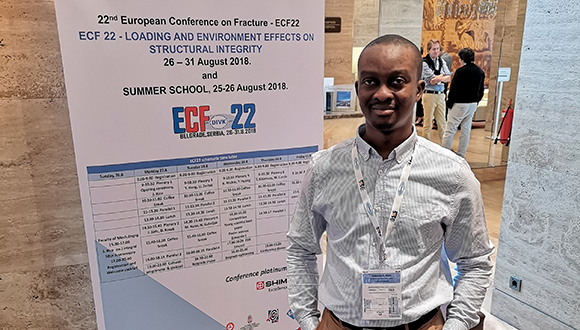Mon, 18 November, 2019
 Aderinkola presenting his research at the European Conference on Fracture. Photo: Aderinkola Alabi
Aderinkola presenting his research at the European Conference on Fracture. Photo: Aderinkola Alabi
NSIRC PhD student Aderinkola Alabi has passed his Viva. His thesis is titled ‘Mechanical Behaviour of High Strength Structural Steel Under High Loading Rates’ and his research was supervised by Professor Luiz Wrobel, Brunel University London and Dr Philippa Moore, TWI Ltd. Aderinkola’s research was supported by Lloyd’s Register Foundation.
Despite offering significant strength-to-weight advantages, high-strength structural steels (HSS) with high yield-to-tensile ratio >0.90, such as S690QL and S960QL, are used only in limited offshore applications. This is due to the lack of material characterisation in regard to their mechanical behaviour (tensile and fracture behaviour), with little data available on the loading rates other than those typically experienced offshore when compared to the dataset available on low strength structural steels with a yield-to-tensile ratio <0.85.
"I appreciate the unflinching support of my supervisors and industrial mentors, and I say thank you to the technicians at the engineering hall and the Test House at TWI, for always being there when I needed to test."
Aderinkola Alabi
In his research, Aderinkola proposed and investigated a programme of mechanical testing combining the tensile and fracture toughness properties of modern HSS (S690QL and S960QL) with high yield-to-tensile ratio under high loading rates, applicable to offshore scenarios. This was supported by finite element analysis on the fracture toughness of S690QL, to determine the crack driving force and the effect of loading rates on the crack mouth opening displacement, which cannot be estimated experimentally using rate dependent material model developed for S690QL. Material model for S690QL is developed at a range of strain rates using a rate-dependent method available in ABAQUS code, in order to allow for the prediction of the flow stress at elevated loading, based on the quasi-static test data.
From the results of Aderinkola’s research, confidence and requirements regarding structural performance can be developed and re-evaluated in relevant codes and standards for these steel materials with high yield-to-tensile ratio, and high strength structural steel can exploit its strength, but not rely on its ability to deform or locally yield under extreme loading for offshore and marine applications.
Aderinkola commented that “The research shows that HSS are less sensitive to the effect of loading rates when compared to low-strength structural steels (LSS), which was made possible by the opportunity to work closely with industry and academia. It accorded me the privilege to use the research facilities at TWI, as well as share and exchange ideas with the organisation’s experts. I appreciate the unflinching support of my supervisors and industrial mentors, and I say thank you to the technicians at the engineering hall and the Test House at TWI for always being there when I needed to test.”